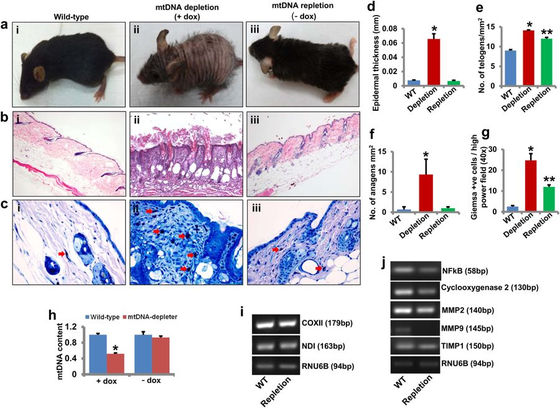It may be possible to eliminate wrinkles and hair loss by genetic editing and stop aging

As I get old, the body will inevitably weaken, especially wrinkles on the face and body increase, body hair gradually decreases centering on the hair, the aging phenomenon appears visible. "How to control aging" is a theme held by humankind since ancient times, but research results have been reported that editing genes might be able to solve such aging phenomena.
Gene Editing Can Reverse Aging Signs in Mice. Maybe Humans Next? | Digital Trends
https://www.digitaltrends.com/cool-tech/reversing-wrinkling-balding-mice/
Reversing wrinkled skin and hair loss in mice by restoring mitochondrial function | Cell Death & Disease
https://www.nature.com/articles/s41419-018-0765-9
The research team at the University of Alabama, Birmingham, has advanced research on whether genetic editing can be used to artificially counteract aging. Among them, the research team focused on the relationship between mitochondrial functionality and aging process.
Mitochondria is an intracellular organelle that plays a role in producing intracellular energy. Mitochondria, which is said to begin to co-exist in eukaryotic cells with one species of aerobic bacteria, contains its own mitochondrial DNA (mtDNA) apart from cells.

As a factor of the aging phenomenon due to aging, mutation of mtDNA has been pointed out before. MtDNA with a single cyclic structure is more likely to be damaged than nuclear DNA with a double helical structure and increasing mtDNA that gets little by little increases the function of cells and organs and may lead to aging That is the theory. However, it has not been clearly known how mtDNA damage specifically causes aging phenomena.
The research team mutated a part of the gene called POLG1 to create mice in which mtDNA depletion is induced in various tissues. In mtDNA-depleted mice, the mitochondria itself in the body decreases and the production of adenosine triphosphate (ATP), which is the energy currency in the body, also fails. As a result, it is almost impossible to convert from what you eat to 'energy that cells can use'.
As the function of mitochondria was reduced by depletion of mtDNA, it turned out that mice had visible aging phenomena such as "sagging of skin" and "hair loss". In the image below, the center and the right mouse are mtDNA depleted type, but it is clear that the skin is sagging compared to a healthy mouse (left), the body hair falls out and the pink skin is visible.

Further investigation of the mouse revealed that sagging of the skin occurred due to thickening of the epidermis, increase in horny quality, increase in proteolytic enzymes, and hair loss occurred due to malfunction of "hair follicles" enveloping the hair root It turned out that the expression of gene sites related to aging has changed.
The research team then turned off the mutation that induces mtDNA depletion in the same mouse, and then restored mitochondrial function by supplementing mtDNA. Then the skin of the mouse became smooth, the thick fur came back and rejuvenated to a level indistinguishable from a healthy mouse of the same age. Among the following images, the left is a healthy mouse, the middle is the mtDNA depleted mouse, and the right is the right mouse. In comparison, you can see that not only the appearance but also the organization whose shape has collapsed is recovering.

Mr. Keshab Shin, a professor at the University of Alabama at Genetics, Pathology and Environmental Health, said, "DNA content of mitochondria and mitochondrial function decline are observed, especially in the elderly, By restoring the function of mitochondria by genetic editing, we can return the wrinkled skin to normal and healthy skin and recover hair growth. " The research team believes that the results of this experiment can be applied to human beings in the future, not only to reduce skin sagging and hair loss, but also to treat cardiovascular diseases, diabetes, neurological disorders associated with aging, cancer, etc. I also expect it.
Related Posts:







